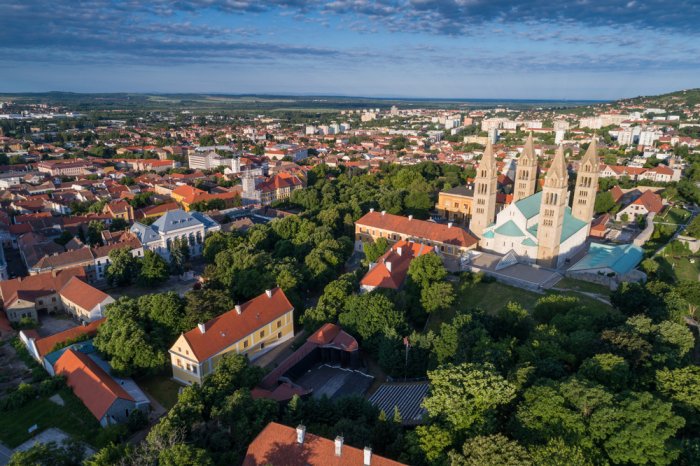A Future Made in Central and Eastern Europe

Central and Eastern Europe will play an increasingly important role in the European Union’s economy in the future. Digitization and current technological changes can give the region further impetus but to benefit from them, these economies need to stay open to new technologies and be able to adapt quickly to the changing environment.
“Made in CEE” roundtable discussion.
These were the most important messages from The Future’s “Made in CEE” conference organized by the German-Hungarian Chamber of Commerce and Industry (DUIHK) at the end of October.
The DUIHK has already been running several programs to help its members better prepare for the above mentioned changes. One is Netzwerk Digital, an initiative launched earlier this year, the aim of which is to support member companies with pragmatic solutions and by sharing experience to apply digitization successfully.
Speakers at the conference – László Palkovics, Minister for Innovation and Technology, Johannes Teyssen, chairman-CEO of E.ON SE in Essen, Hans-Paul Bürkner, president of the Boston Consulting Group in Frankfurt, and Thomas Narbeshuber, vice president of BASF’s chemical company – agreed that the region is now an indispensable element of European value chains and that its importance will continue to grow in the coming years.
The countries of Central and Eastern Europe could also benefit from the opportunities presented by today’s rapid technological changes, such as digitization and development towards “Industry 4.0”.
In his keynote speech, Teyssen, talked about the importance of the region and how CEE and Hungary can become successful in a future characterized by swift social and technological changes.
“I believe CEE should be well prepared to prosper from these changes. The ability of these nations that have learnt to embrace change will put them in the right place in the more digital place that is ahead,” he said.
R&D Framework
Minister for Innovation and Technology László Palkovics addressed issues related to digitization and technological change, as well as the framework conditions that the state must create to support R&D and innovation.
“In order to create a future you need to have a solid basis,” Palkovics said. “Normally, the Hungarian economy is strongly linked to the German economy; still, we have [seen] some sort of a decoupling we were looking for an answer too,” he continued.
Part of the explanation for the decoupling of the Hungarian and German economy is the proportion of high-tech production: Hungary is on the same level as Germany and Denmark, and regarding the ratio of high-tech exports, Hungary is number one in Europe, the minister said.
Some may say that the fact that Mercedes decided to bring manufacturing here has nothing to do with the level of technological development. Yet it does; in deed, many of recent investments made in the country are made by companies with a high-level of high tech – and they have also decided to bring activities such as research and development here, he argued.
The minister also listed the number of challenges the country needs to tackle in order to become a more innovative country. Among these are financing, collaboration between organizations and structural changes in the system.
“The Hungarian R&D system has many challenges; people could witness the fights that happened as a result of the restructuring of the researching and science network,” Palkovics noted, talking about the arguments over the summer with the Academy of Sciences.
Funding is also low, he acknowledged. The state will increase its R&D funding by 25% next and in 2021 and 2022 as well, which means that it will double the current level, he added.
Greater Cooperation
Another issue the minister highlighted is a lack of willingness by many organizations to cooperate.
“They are quite individualist: universities are not working with each and the level of cooperation with and between companies is not high either. We have to deal with that as well,” Palkovics said.
R&D funding as percentage of GDP falls short of the European average, and will remain under the 3% target figure set by the European Union for 2020.
With the measures announced, Hungary is likely to end close to 2%, but the target to reach by 2030 should be 3%, he added. In the next funding period, the EU will set aside its biggest budget for R&D yet: as of 2021, the European Union’s Horizon Europe program will allocate EUR 100 billion.
In order to successfully tap into this, cooperation – between countries as well – is key, the minister said. Talking about the composition of R&D funds in Hungary, the minister said that currently the majority of financing (75%) is made by the private sector. This will change in the coming years; by 2021, community funds will provide a third.
The speakers talked about the impact of digitalization and technological breakthroughs on the labor market and society. According to Teyssen, a successful digital transformation requires an appropriate culture.
Above all, employees need to be encouraged to acquire digital knowledge. Palkovics acknowledged that Hungary still has some work to do in developing people’s digital competences.
Boston Consulting Group president Bürkner agreed: Workers need to be prepared for this new era and investment in digitization needs to be encouraged, he said.

László Palkovics
SUPPORT THE BUDAPEST BUSINESS JOURNAL
Producing journalism that is worthy of the name is a costly business. For 27 years, the publishers, editors and reporters of the Budapest Business Journal have striven to bring you business news that works, information that you can trust, that is factual, accurate and presented without fear or favor.
Newspaper organizations across the globe have struggled to find a business model that allows them to continue to excel, without compromising their ability to perform. Most recently, some have experimented with the idea of involving their most important stakeholders, their readers.
We would like to offer that same opportunity to our readers. We would like to invite you to help us deliver the quality business journalism you require. Hit our Support the BBJ button and you can choose the how much and how often you send us your contributions.








